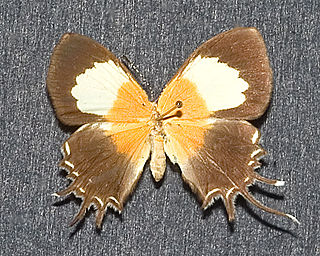| Helicopis | |
|---|---|
 | |
| Mounted Helicopis gnidus from Brazil | |
| Scientific classification | |
| Kingdom: | |
| Phylum: | |
| Class: | |
| Order: | |
| Family: | |
| Genus: | Helicopis Fabricius, 1807 |
| Synonyms | |
| |
Helicopis is a Neotropical genus of butterflies of the family Riodinidae.
| Helicopis | |
|---|---|
 | |
| Mounted Helicopis gnidus from Brazil | |
| Scientific classification | |
| Kingdom: | |
| Phylum: | |
| Class: | |
| Order: | |
| Family: | |
| Genus: | Helicopis Fabricius, 1807 |
| Synonyms | |
| |
Helicopis is a Neotropical genus of butterflies of the family Riodinidae.

Riodinidae is the family of metalmark butterflies. The common name "metalmarks" refers to the small, metallic-looking spots commonly found on their wings. The 1532 species are placed in 146 genera. Although mostly Neotropical in distribution, the family is also represented both in the Nearctic and the Palearctic.

The Helicopini are a tribe of metalmark butterflies.
Helcystogramma is a genus of moths in the family Gelechiidae. The genus was erected by Philipp Christoph Zeller in 1877.

Lecanora is a genus of lichen commonly called rim lichens. Lichens in the genus Squamarina are also called rim lichens. Members of the genus have roughly circular fruiting discs (apothecia) with rims that have photosynthetic tissue similar to that of the nonfruiting part of the lichen body (thallus). Other lichens with apothecia having margins made of thallus-like tissue are called lecanorine.
In the 10th edition of Systema Naturae, Carl Linnaeus classified the arthropods, including insects, arachnids and crustaceans, among his class "Insecta". Butterflies and moths were brought together under the name Lepidoptera. Linnaeus divided the group into three genera – Papilio, Sphinx and Phalaena. The first two, together with the seven subdivisions of the third, are now used as the basis for nine superfamily names: Papilionoidea, Sphingoidea, Bombycoidea, Noctuoidea, Geometroidea, Torticoidea, Pyraloidea, Tineoidea and Alucitoidea.

Helicopis gnidus, the gnidus metalmark, is a species of butterfly in the family Riodinidae.
Helcystogramma helicopis is a moth in the family Gelechiidae. It was described by Edward Meyrick in 1922. It is found in Peru and Amazonas, Brazil.
| | This Riodinidae-related article is a stub. You can help Wikipedia by expanding it. |